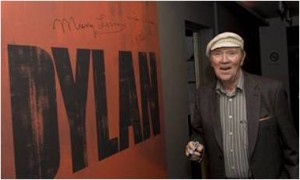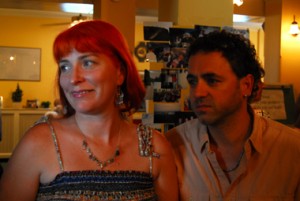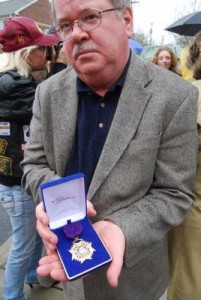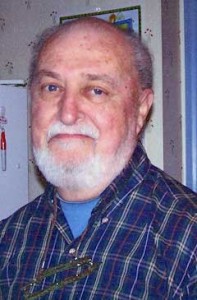“The person of a man may leave, or be taken away, but the best part of a good man stays. It stays forever.”
— William Saroyan, The Human Comedy
Frank Malley didn’t just have a zest for life, he had a hammerlock on it. The doctors who diagnosed his cancer gave him 18 months to live. He turned it into five years of “not doing anything I don’t want to do,” as he told me about a year ago, standing at the bar at the Irish Center, nursing his Guinness.
He was a singer, story teller, world traveler, and as organized as the blueprints he worked on as an architectural steel detailer, which stood him in good stead when he joined the Philadelphia Ceili Group in the 1970s. He chaired its annual festival of Irish traditional music and dance for the last decade, even while enduring grueling rounds of chemo. When it came to labors of love, he couldn’t stop, not even for cancer.
“A few years ago, when he had just finished up a round of chemo and was still recovering and very weak, he came to do my radio show and talked for a solid hour about the upcoming festival,” recalls Marianne MacDonald, host of the WTMR radio show, “Come West Along the Road.” “I told him that he shouldn’t do it if he wasn’t up to it, and he really wasn’t, but he did it. He was such a fighter, so totally dedicated.”
Malley was at his draftboard—where he worked on high profile architectural projects such as the Philadelphia Art Museum expansion and the Academy of Music restoration—until a few weeks ago. “Most people didn’t even know he was sick,” says his daughter, Courtney, a singer who inherited her love of music and Irish culture from her father, the son of immigrants.
Frank Malley, 67, died this week at home, surrounded by his family. “He was my best friend,” says Courtney who, like her father, serves on the board of the Ceili Group. “I keep telling my family, yes, this is a huge loss, and that’s the double- edged sword. With my father, there were no boundaries between generations. We were friends as well as family, and that makes it even harder to lose him.”
Many of those who knew him for a long time considered him family as well as friend. Robin Hiteshew, a contractor and photographer who co-chaired the Ceili Group Festival with Malley in the 1980s, traveled with him to Ireland, and commiserated with him about living with cancer. “That was another thing we had in common,” says Hiteshew, a cancer survivor who records and archives performances at the Irish Center.
He admitted that the two occasionally butted heads. “Frank was a bull,” he says, fondly. “But he was straight up. You always knew where you stood. He blew steam out his ears like most Irishmen, and you didn’t want to be on the wrong side of his temper, but his motivation was always the best. He wanted the best for the festival. What can I say? That was Frank. He was my friend. And in the end, our friendship held us together.”
With Frank Dalton, a Ceili Group member and founder of the Coatesville Traditional Music Series, Malley shared a love of Irish and old-time music. And they didn’t always agree either. “But Frank was really open-minded,” says Dalton. “He knew he didn’t know everything there was to know about traditional Irish music but he listened. He listened to whatever anyone was saying and he took advice, something most of us have trouble doing. He was one of the sharpest, most intelligent guys I ever met.”
It safe to say that many never knew what Frank Malley did for a living, except for the steel erectors in the city who “came to him when no one else could figure out a job,” says Hiteshaw. “Everyone would come to him because he was accurate. He was the master of his trade. He was the best structural steel detailer around. He made the actual nuts-and-bolts drawing that tells steel erectors how to bolt beams together so they fit correctly and look like the architectural drawing said they should look.”
A few weeks before his death, says his daughter, she helped him put his office in order. “I have about 50 of his drawings, which he did by hand, not by computer, that are works of art.”
Most people knew Frank Malley as as a singer and storyteller. He made two CDs, “Live at the Mermaid” and “The Captain’s Old Dog.” He performed regularly at the Ceili Group Festival, the Philadelphia Folk Festival (he was also a member of the Philadelphia Folk Song Society), and the Heritage Dance Festival.
“He didn’t get involved in music till he was a teenager and he loved listening to Big Band and jazz, classical music and folk, and he was always an opera fan,” recalls Courtney. “He loved old cowboy tunes and bluegrass, but with Irish music he found the love of his life.”
Malley was born in Norristown to Patrick and Katherine Duffy Malley. His father was from Coor Point, Donegal, and his mother from Skaheen, Kilmove, County Mayo. His father was the resident farmer on the Highlands estate in Whitemarsh, a Georgian house dating to 1794, which now belongs to the state and is open as a museum. Malley’s father worked for the Roosevelts, relatives of President Teddy Roosevelt, who owned the property for many years.
“He seemed to get a lot of nurturing from his parents in the Irish culture,” recalls friend Jim McGill, a Ceili Group board member. Once, he said, Malley organized an Irish event at the Highlands. “He had tried to set up a museum there to honor the Irish domestic people who came over and worked for people around the Hill, but the hobnobbers wouldn’t have anything to do it. When we had our festival there, Frank said the former owners ‘would be turning over in their graves if they knew the Irish were having fun on the lawn.’”
If he were writing Frank Malley’s obituary, Hiteshew says, “I would have to call Frank a seanchaí, a modern seanchaí, a storyteller, and a hardworking man, someone you could depend on who gave you his word and stuck to it. I think he would want to be remembered as the guy who worked hard for the Ceili Group, an active member of the Folksong Society, who was devoted to his family.”
In addition to his daughter, Frank Malley is survived by a son, Bryan Patrick Malley; brothers John and James Malley; his longtime companion, Connie Koppe; his former wife, Rose Marie Burke Malley, and five grandchildren.
A memorial service will be held at 3 p.m. Saturday, August 1, at the Irish Center, Emlen Street and Carpenter Lane in Mt. Airy. Memorial donations may be made to any member of “Team Canada” for the Breast Cancer 3Day walk at www.the3day.org.
Listen to a few tracks from Frank Malley’s CDs, thanks to Frank Dalton.
See a compilation of photos of Frank Malley.
View photos as a slide show.
What others have to say:
Anne McNiff, Philadelphia Ceili Group Member
I unfortunately only knew Frank a short time. We met the summer of 2007. As a relative new-comer to Mount Airy, I attended a Ceili Group meeting thinking that I might be interested in volunteering a time or two, given that I loved Irish traditional music and was looking for a way to become more involved in the local community. Little did I know how going to that meeting would change my life!
Frank was festival chair and spoke passionately about what still needed to be done to prepare for the festival and I remember thinking that he was getting quite riled up about what seemed to me, at the time, to be a relatively uncomplicated event. (Ha! Little did I know!) There was concern at that time about e-mails going out about the festival in a timely manner and the Web site. I tentatively raised my hand and said I would be happy to help out with both those things if I could. I was immediately put on a committee and plans were made to meet with Frank about the issues specific to the festival. We met up a short time later and so it began.
There are some people that you meet that you immediately are drawn to their commitment and passion about what they are doing. Frank was that kind of person. Don’t get me wrong, Frank had no delusions about the festival, the people working on it, or the people attending. As a matter of fact, he had a few pithy remarks about all three groups! His dry, somewhat cynical, wit but obvious love for the event and the people involved really drew me in.
And so, after doing what I could to help in advance, I showed up on the Saturday of the festival and reported to Frank. He told me, “Annie (one of the few outside my immediate family who calls me that), I have someone I want you to meet, I think you will both like each other very much.” This was quite a intimidating introduction to his daughter, Courtney Malley, who amidst running the door, chasing after twins, and generally being second in command, took the time to get my story and tell me it didn’t matter if I didn’t really know anyone and didn’t have much to do outside of work. That would now all change, starting on Thursday nights. I think Frank may have had a small, self-congratulatory smile.
And so because of Frank Malley and his uncanny way of bringing people together, I found my community, a group of friends I have come to love and care about more then I can say. A group of people that Frank and his family are at the center of.
I loved the “Renaissance man” aspects of Frank’s personality—the man who would tell me a bawdy story as easily as he would discuss fine French and Italian wines; who talked about theater we had both seen (or been in) and the World Series; who made me laugh and think and mostly just smile to be in his company.
Because of his death, it feels like there is a hole in the fabric of so many of our lives. I will miss him very much.
Mary Lou McGurk, President of the Philadelphia Ceili Group:
I don’t remember when I met Frank. It’s been so long that I feel that I have always known him.
I was a teenager when I joined the Ceili Group in 1976. They had already held one festival that I missed, and I can’t remember if Frank was involved, but I do remember the next couple. They were held at Fisher’s Pool in Lansdale, and it was the boonies. It was a big, open place. It was hard to believe that a festival would be there.
Frank had a crew of workers that would go there a few days in advance and change it from an open field to a concert area. He had plans and sketches! He rented flatbed trucks and turned them into stages. On the day of the festival he was like magic. Anything that you needed, he was there: fix a sign, move a speaker or rig up a hospitality area for the musicians. He was all ready to help and so were all the people on the committee. He had the attitude that he was there to make things run smoothly and he wanted his people to have that attitude also. He was a great leader.
I remember when we were trying to set the prices–most of the people on the festival were young and single. We didn’t know how to price tickets for children. Frank used Courtney as the measure for the cut-off; anyone Courtney’s age or younger got in for free. Of course, every year the age limit went up until she was 17, I think.
People drifted in and out of the PCG as their lives made different demands, but Frank was a constant. He even talked me back onto the board a few years ago, and I don’t regret it. He was a good man.






